This post is part of my Randomly London v. The Tube Challenge. Get the latest about challenge updates here. Donate to Bowel Cancer UK here.
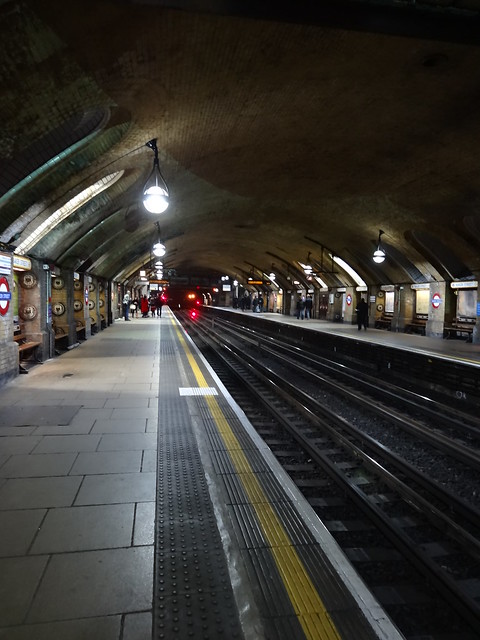
The best set of platforms on the entire network? I think so.
While the Hammersmith & City (H&C) line operates along the entire original section of the London Underground, it has only been shown as a separate line on the tube map since 1990. This means that it’s technically London’s newest tube line, although no new track or stations were built when the route was transferred from the Metropolitan line.
With the extension of the Circle line all the way to Hammersmith in 2009, the Hammersmith & City line no longer has any unique stations. Nevertheless, here are some photos, facts and my impressions of each of the 29 stations that currently make up the line:
Hammersmith (Hammersmith & City and Circle lines)
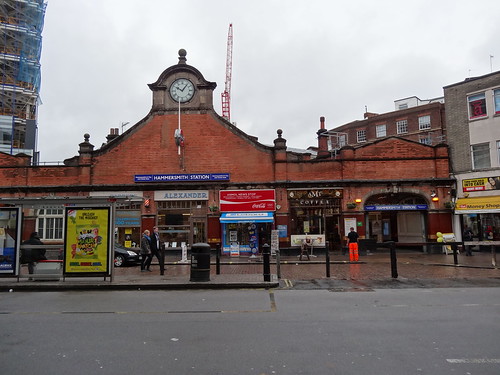
Entrance to Hammersmith station for H &C and Circle lines
Impressions: The modern Broadway shopping complex totally dominates the area around here and houses one of the two Hammersmith stations on the network. However, if you want to catch the H&C trains you’ll have to cross Hammersmith Broadway. In my opinion this is the much nicer of the two stations, although it increasingly feels dwarfed by the surrounding buildings.
Random Fact: Opened in 1868, it’s the older of the two stations named Hammersmith. The other opened in 1874 and serves the Piccadilly & District lines. The two stations are about 135m apart by foot.
Goldhawk Road
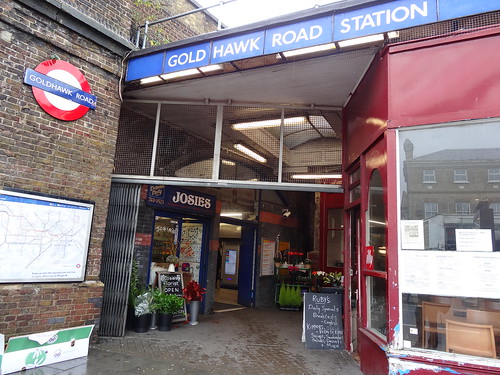
Western entrance to Goldhawk Road station
Impressions: Goldhawk Road could equally well be called Shepherd’s Bush Market since it’s located at its southern end. The area outside the station is not particularly busy but does seem to be home to people of many different cultures. The station itself was unmanned the day I visited and seems run down.
Random Fact: Even though the line to Hammersmith opened in 1864, the station was not built until 1914.
Shepherd’s Bush Market
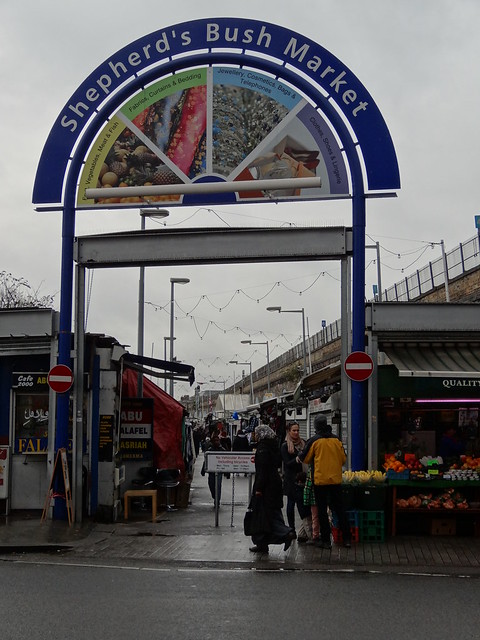
The northern entrance to the actual Shepherd’s Bush Market from which the station gets its name
Impressions: The actual Shepherd’s Bush Market station looks and feels very similar to Goldhawk Road, which is no surprise given that they are only a few hundred metres apart. The main difference is that this station is much busier and the area outside is livelier. Nevertheless, it still feels a little worn and run down.
Random Fact: From 1914 to 2008 it was known as Shepherd’s Bush. The name was changed to avoid confusion with the Central and Overground line stations of the same name, which are 480m from here. If the name hadn’t been changed, there would have beenthree stations called Shepherd’s Bush.
Wood Lane
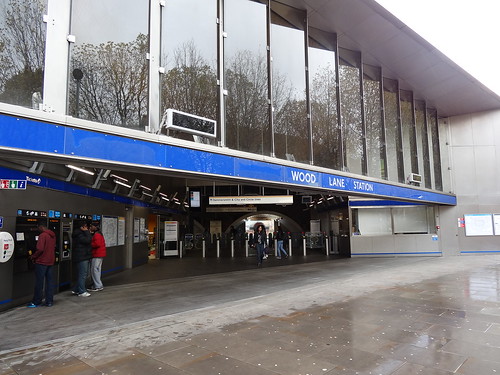
The incredibly wide entrance to Wood Lane station.
Impressions: Completely different from the previous two stations. It’s clean, modern and very spacious. You’ll likely notice one of two things when leaving the station either the BBC Television Centre (soon to be renamed) and/or the massive Westfield Shopping Centre. A practical if not particularly memorable station.
Random Fact: The newest station on the Underground network, it only opened in 2008 but takes its name from a former nearby station that closed in 1959.
Latimer Road
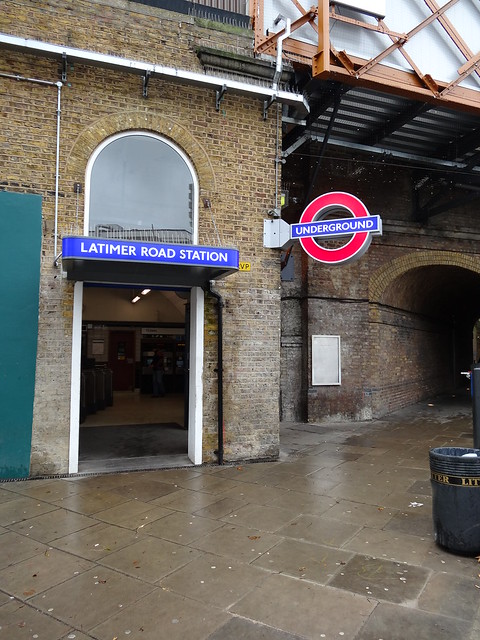
Latimer Road entrance
Impressions: This is the first station in Kensington & Chelsea, but this is not the posh end. You may not know this, but the northern wards of the borough are among the most deprived in the country. Few people seem to use the station and it was unmanned the day I visited. Yet, I really like it because it has a hole-in-the-wall feel.
Random Fact: The station is around 500m from road that gave the station its name. Latimer Road used to run closer to the station, but the construction of the Westway changed that.
Ladbroke Grove
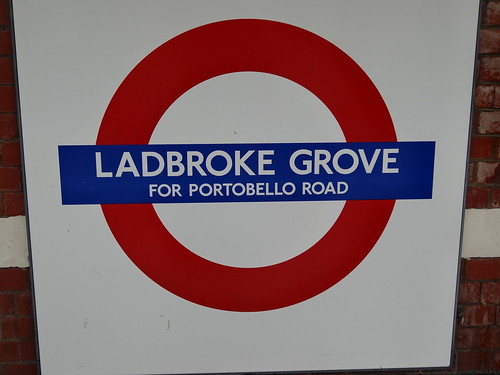
Ladbroke Grove for Portobello Road Roundel
Impressions: If you head north after leaving the station you’ll immediately pass under the Westway, one of London’s greatest urban planning follies. No doubt it was allowed to go ahead in part because this still is not the rich part of K&C. The station is not really that remarkable, although it was rather busy because of the crowds going to Portobello Road market.
Random Fact: Includes ‘For Portobello Road’ in the roundel, one of only three stations to do so and the only one on the Hammersmith & City line.
Westbourne Park
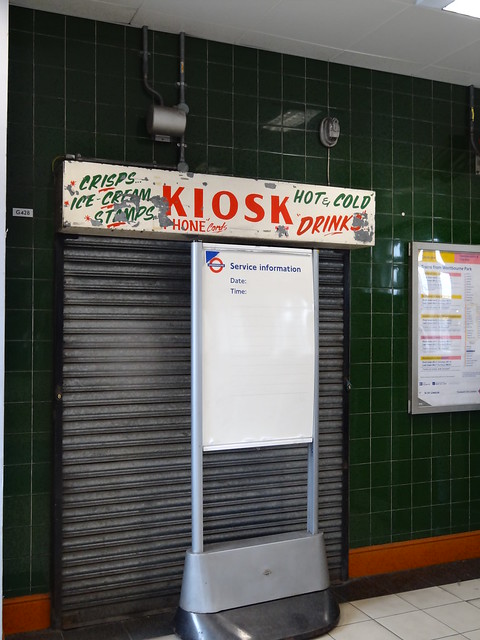
Possible disused kiosk at Westbourne Park
Impressions: There is not much outside when you leave Westbourne Park station – the Westway immediately to the north and the Metropolitan Pub immediately to the south. The station building seems abnormally large given the relatively small number of passengers who seem to be using it. Nice but, again, not really memorable.
Random Fact: In February 1913 a bomb was discovered at the station.
Royal Oak

Platform and rail lines at Royal Oak station
Impressions: Royal Oak is an island in a sea of rails. It’s old, run down, unmanned on weekends and feels almost as if it’s been forgotten about. I really like it because it feels hidden in plain sight.
Random Fact: Built by Great Western Railway it served main line trains until 1934, but was not transferred to London Transport until 1970.
Paddington
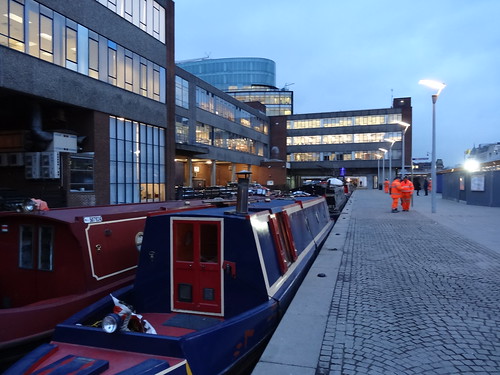
The northern of two Paddington stations exits onto the Regent’s Canal
Impressions: This is the northern of the two Paddington underground stations. They are separated by the whole length Paddington mainline station. This one has recently been renovated to provide modern platforms. While clean and functional, it does not really preserve any of the station’s history.
Random Fact: Paddington (Bishop’s Road) was the terminus for first ever underground line from Farringdon. It opened on 10 January 1863.
Edgware Road
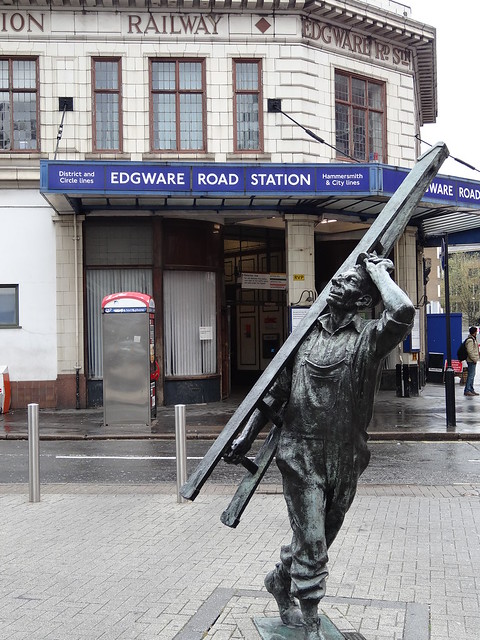
Looking Up Edgware Road Station
Impressions: Again this is one of two stations called Edgware Road. The other is a short walk away and serves the Bakerloo line. In my opinion, this is the nicer of the two and you can still signs that it was built by the Metropolitan Railway. I do however find the station slightly bizarre as the station building is entirely on its own with no other adjoining houses, offices, or even shops.
Random Fact: 6 people were killed on 7/7 (7 July 2005) when one of the four bombs exploded on a train just leaving the station.
Baker Street

Playing with the red filter at Baker Street station.
Impressions: When I first visited Baker Street on my Bakerloo line station visits, I was less than impressed. I must have been in a bad mood, because the eastbound Hammersmith & City and Circle line platform is arguably the best on the whole network – it’s the tube as it was meant to be!
If you have to see only one tube platform, this should be the one!
Random Fact: Dating from the tube’s opening in 1863, the eastbound Hammersmith & City and Circle line platform is the best place on the underground network to see what the original stations looked like.
Great Portland Street
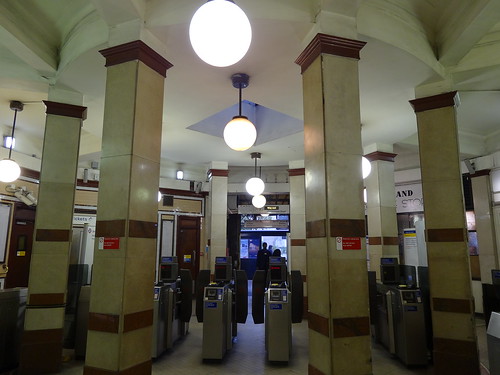
Ticket hall at Great Portland Street Stationstation
Impressions: Great Portland street is one of those stations that you generally do not visit unless you have a reason to be in the area. This is a shame because the exterior (under construction when I visited but now complete), ticket hall (see above) and platforms (combination of old and new) are all worth a look.
Random Fact: At one point, Great Portland Street had a car show room among its shops.
Euston Square
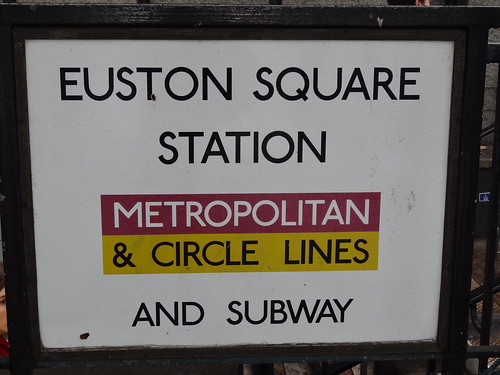
Ummm… I think you may be missing a line that calls at this station.
Impressions: Euston Square is small drab station that is not particularly memorable. Despite its name, it’s frustratingly not directly connected with Euston station. This means you have to walk 5 minutes above ground and pay a second fare if you want to transfer (Apparently counts as out of station interchange, so only one fare should have to be paid). The one good thing about the station is that it serves as a subway under the very busy Euston Road.
Random Fact: Opened in 1863 as Gower Street, with the current name being used since 1909.
King’s Cross-St. Pancras
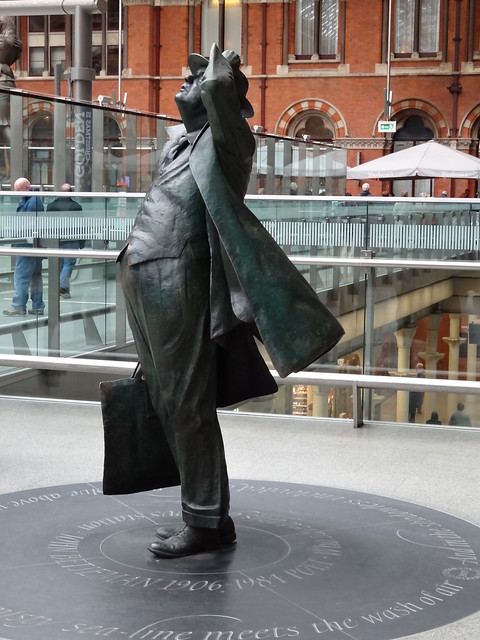
How I look every time I visit St. Pancras.
Impressions: Since I will visit King’s Cross-St. Pancras 6 times during this project, I decided very quickly that I’d have to look at different bits of the station each time or go crazy (the underground station is pretty unremarkable). On this visit I opt for St. Pancras International, which in my opinion is best station in the UK and a great way to welcome to people arriving on the Eurostar. Just be sure to look up.
Random Fact: The station is tied with Waterloo and Canary Wharf for having the most escalators within the Underground ticket barrier ‘boundary’ with a total of 20.
Farringdon
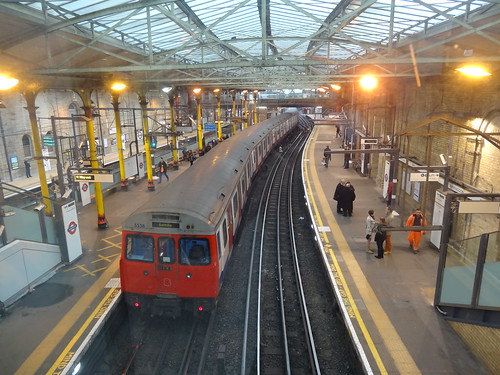
Inside of Farringdon station with a Hammersmith & City line train
Impressions: Farringdon has to be one of my favourite stations on the whole network and will soon be one of the busiest as it will be a central hub for both Crossrail and Thameslink. The station seamlessly combines the old with the new. If you happen to visit on a weekend, be aware that it’s on the edge of the City and there is not a lot open in the surrounding area.
Random Fact: The lines from King’s Cross to Farringdon run alongside the now covered Fleet River.
Barbican
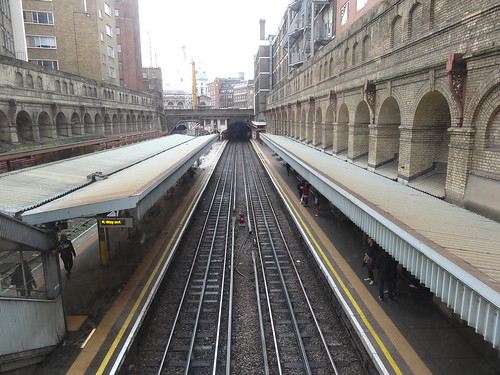
The straight and boring platforms at Barbican station
Impressions: The Barbican Estate is among my favourite places to walk in London. It’s ugly yet intriguing, full of secret passageways and hidden businesses. On the other hand, Barbican station is just boring. The only slightly interesting feature is that you can access the station via a high walk and walk all the way to Moorgate station without ever being at street level.
Random Fact: The station replaced a building which claimed that “This was Shakespeare’s House”, although the documented evidence for the claim is somewhat sketchy.
Moorgate
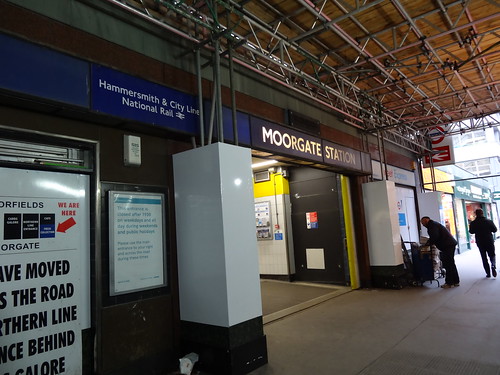
Moorgate Hammersmith & City Line entrance with scaffolding
Impressions: Moorgate is one of those stations that has a dual life. Come here on a workday and it’s packed. Come here on weekend and it’s empty – so empty that it feels almost creepy to be walking around inside. Given that the station’s interior has few obvious merits, there is no reason to linger.
Random Fact: Originally opened in December 1865, it was one among the first stations added to the network after the original Paddington-Farringdon route was extended.
Liverpool Street

Why is this exit always closed whenever I use the station?
Impressions: Liverpool Street is among my least favourite major national rail stations, because I do not think the 1980s renovation entirely works with the Victorian-era station. The tube portion of the station is also pretty unremarkable. And, frustratingly, the exit to Old Broad Street is always closed at weekends, which just so happens to be the exit I always try to use.
Random Fact: The south-east corner of Liverpool Street station is built on the site of the original Bethlem Royal Hospital, which later became an infamous mental hospital and origin of the word bedlam.
Aldgate East
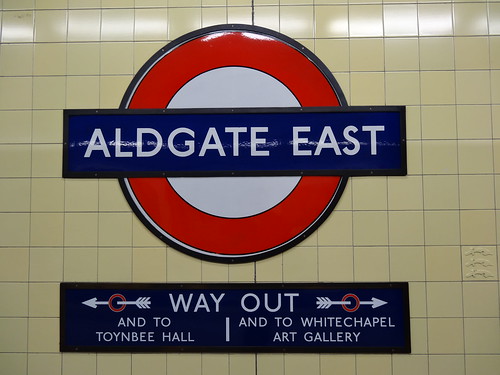
Aldgate East roundel and directions to both exits
Impressions: Between Liverpool Street and Aldgate East you say goodbye to the Circle line and hello to the District line. Unlike the majority of stations, Aldgate East has entrances at each end of the platforms. While handy during the day, they do close the eastern entrances earlier than the western ones, which can make seem as if the station closes earlier than it really does. Once inside the station, be sure to look at the tiles on the walls.
Random Fact: Before the current station could open in October 1938, the track was lowered by 7 feet. They kept the line open during the day using wooden trestles to support the track while excavating underneath. 900 workmen then lowered the whole track simultaneously in one night.
Whitechapel
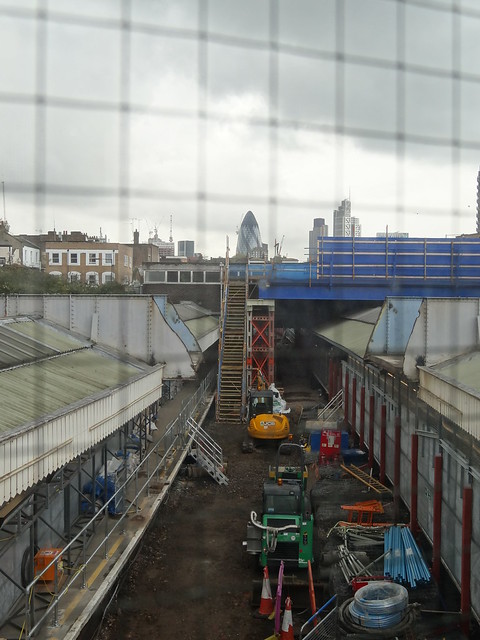
Track upgrade at Whitechapel in preparation for Crossrail
Impressions: Visiting Whitechapel feels like visiting a building site. A large section of platform space has been taken over by fencing to provide space for work on Crossrail. The station does have some great vintage wooden stairs that take you to the main ticket hall. Once outside, there is a busy street market where it looks like you can buy just about anything.
Random Fact: Whitechapel is the only place on the network where the Overground runs below the Underground.
Stepney Green
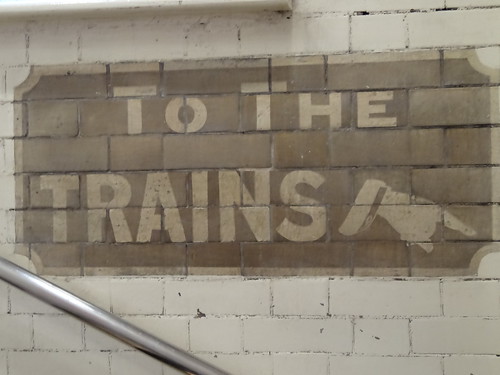
Vintage “To the Trains” sign
Impressions: Stepney Green is a far less busy than Whitechapel, with relatively little going on outside. While the station retains many of its heritage features, it’s not overly memorable.
Random Fact: It’s the only station with the unique sign (above) directing people to the trains with a pointing finger.
Mile End

Mysterious “Nearly Home” message written on crosswalk button outside Mile End station
Impressions: Mile End is lively but not exactly busy. One thing I notice about the station is the cross-platform interchange with the Central line. These are one of the great features of the tube. However, like Stepney Green, the station does not really stand out for any other reason.
Random Fact: Mile End is the only subterranean station on the network that offers a cross-platform interchange between a deep level line (Central) and a sub-surface line (District and Hammersmith & City lines).
Bow Road
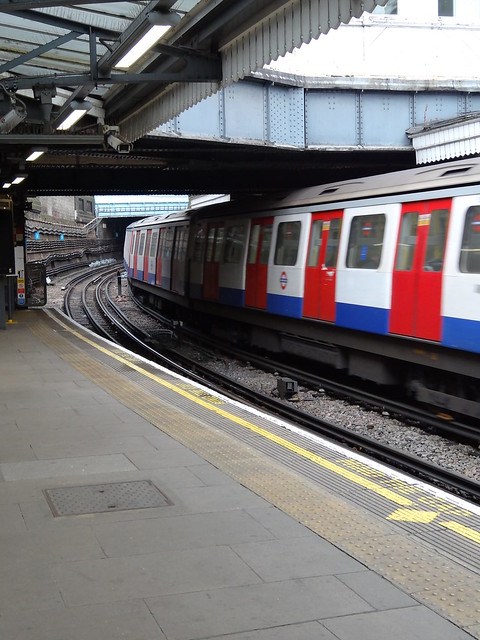
Train heading west coming around curved track
Impressions: Bow Road is a small, quiet station. You get the impression that you really are beginning to leave central London behind. The main thing you notice here is that the track curves away steeply at the eastern end of the platform.
Random Fact: The steepest track gradient on the network, at 3.57 per cent, is between here and Bromley-By-Bow.
Bromley-By-Bow
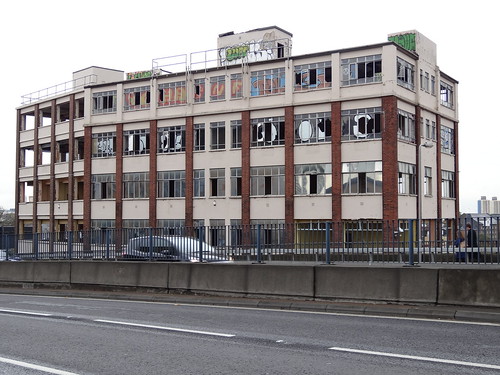
The view upon leaving Bromley-By-Bow station
Impressions: Bromley-By-Bow has to be in the running for one of the ugliest station exits. You’re immediately on the A12 and in front of you is the abandoned building above. Even once this area gentrifies, it’s hard to imagine it that it will ever be beautiful.
Random Fact: In EastEnders, the fictional Walford East tube station takes the place of Bromley-by-Bow.
West Ham
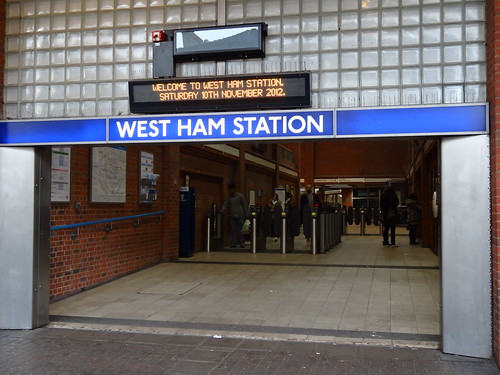
Entrance to West Ham station with the date of my visit
Impressions: West Ham is a modern, large, and ugly station. On the first of my three eventual visits, I was met by a huge police presence. Later, I learned that they were there to prevent trouble from a bunch of EDL supporters protesting outside a mosque. Not a great first impression.
Random Fact: When the station opened in 1901, it was initially known as West Ham. However, it was renamed West Ham (Manor Road) in 1924. It reverted back to its former name in 1969, when ownership of the station was transferred to London Underground.
Plaistow

The rather dull Plaistow station
Impressions: Plaistow is much less busy than West Ham on the day I visit. Not a bad thing given the company at the previous station. Plaistow retains several classic elements, but does not really impress.
Random Fact: Although the station was opened by the London, Tilbury and Southend Railway in 1858, it does not currently does not serve any national rail trains.
Upton Park
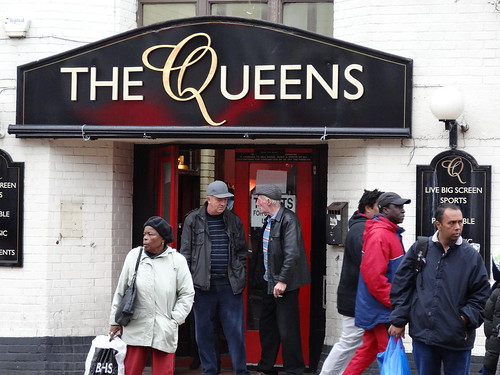
Changing faces of East London outside the Queens Pub
Impressions: Upton Park is another typical Victorian station. However, the area outside is the real surprise. Not since Whitechapel has the street outside the station been so busy and so diverse. One big draw is West Ham’s stadium, but even on a non-game day, you could be forgiven for thinking you are closer to central London than you are. The station is also next to Queen’s Market, the former home of Muhammad Shahid Nazir – aka £1 fish man.
Random Fact: Confusingly, Upton Park is the closest station to Boleyn Ground, where West Ham United play.
East Ham
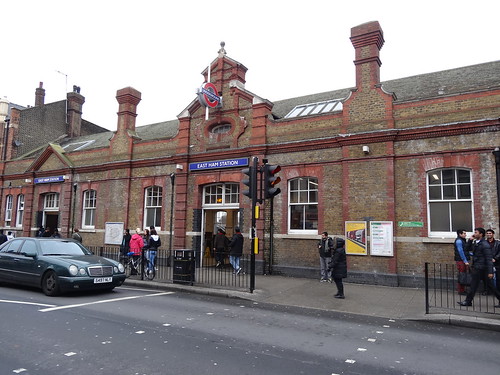
East Ham station building
Impressions: I do a bit of a double take when leaving East Ham station because the building and the area outside look almost exactly like Upton Park. Once again, it’s an old Victorian station featuring a diverse and busy high street.
Random Fact: Between 1905 and 1908, East Ham served as the eastern terminus of the electrified portion of the District line. Customers who wished to go further east had to transfer to steam trains.
Barking
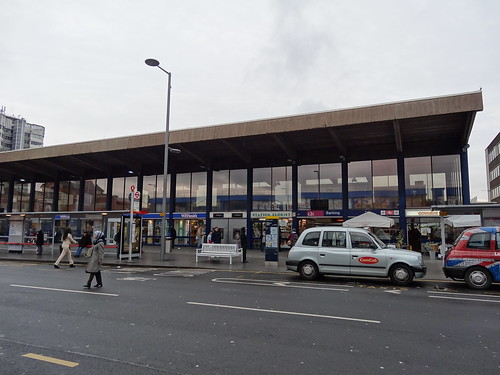
The mysteriously Grade II listed Barking station
Impressions: Alighting from the train at Barking, I am surprised to find that there are no Barking roundels. This is because the station is not owned by London Underground but by Network Rail. The next thing I notice is that the station is an ugly concrete block. The high street in front of the station is less busy than the previous two, although it still seems relatively diverse.
Random Fact: Despite only dating from 1961 and being rather ugly, Barking’s ticket Hall has been a Grade II listed building since 1995.
Summary
I feel as if the Hammersmith & City line is in many ways is London’s forgotten line. It has 29 stations, but all served by at least one other line. It’s the newest line included on the map, but most of the stations feel old and run down. It runs for nearly 16 miles, but never through central London, just around it’s fringes.
That said, it does have some wonderful stations including those that formed the original Metropolitan Railway aka the original Underground. I certainly enjoyed visiting some of the stations, but am not looking forward to having to revisit each and everyone of them as I complete each line in turn.
Until that time enjoy these extra facts about the Hammersmith & City Line as a whole:
10 Hammersmith & City Line Facts
- Track Length: 15.8 miles (25.5 kms)
- Number of Stations: 29
- Journeys per Year: 114.6 million.
- Average Journey Time: Hammersmith to Barking takes 63 minutes at peak times, if you do not get off at each station to take photos.
- Opened: Only been shown as a separate line since 1990, making it the newest line on the network.
- Previous Life: Prior to 1990, the line was shown as part of the Metropolitan line on tube maps.
- Tube Heritage Fact #1: Despite being the newest line, it runs along the entire original section of the tube opened in 1863.
- Pub Quiz Fact #1: Contains the newest station on the network (Wood Lane opened in 2008) and several of the oldest stations on the network (Paddington to Farringdon)
- Operation Fact #1: Second line to be upgraded to new 7 car S Stock trains after Metropolitan.
- Operation Fact #2: Since the Circle line was extended to Hammersmith in 2009, the line has not had any unique stations.
line.
Favourite Station: The Hammersmith & City/Circle line platforms at Baker Street are the best on the network. I’m also a big fan of Royal Oak, St. Pancras National Rail station, and Farringdon.
Least Favourite Station: Though I really do not like West Ham or Barking, Bromley-By-Bow has to be the worst on the line.
- Donate money to Bowel Cancer UK
- Subscribe to my RSS feed, follow me on Twitter, ‘like’ my Facebook page, or +1 my Google+ Page
- Write about the challenge on your own blog/website and/or link to this page. To contact me please send an e-mail wrightlondon [at] gmail.com
- Share this page on social media sites such as Twitter/Facebook/Google+, etc. (see buttons at the bottom of this page)
- Follow my current progress here.
- Buy me a pint or a night out (walking is thirsty business) – Just use the Paypal Buy Now Button below